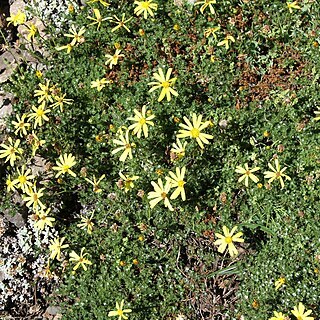Dwarf shrub, up to 0.25 m high; compact, stems erect or procumbent and rooting, divaricate, glabrous or loosely woolly at first, upper parts and peduncles glandular-pilose, densely leafy. Leaves: blade oblong in outline, pinnatisect or bipinnatisect, up to 30 mm long, including broad, half-clasping petiole-like base, lobes up to 4 mm long, young unfurled leaves densely white-woolly (white-woolly leaf buds), later glabrous, with stalked glands. Heads radiate, 1-3 in terminal corymbs. Involucral bracts ± 12, 6-8 mm long, ± equalling disc florets, glandular-pilose, base often cobwebby. Flowers: ray florets ± 13; ray and disc florets bright canary-yellow, Jan.-Mar. Fruit with cypsela (and ovary) cylindrical, ribbed, glabrous.
Perennial, dwarf shrub, compact, up to 0.25 m high. Stems erect or prostrate and rooting, glabrous or loosely woolly at first, upper parts and peduncles glandular-pilose, densely leafy. Leaves oblong, up to 30 mm long, sessile, pinnatisect or bipinnatisect, lobes to 4 mm long, base broad, ± clasping, unfurled leaves densely white-woolly, later glabrous. Inflorescence 1-3 capitula in terminal corymbs. Capitula radiate, disc and rays bright yellow, rays ± 13, long, spreading; involucre turbinate; bracts ± 12, 6-8 mm long, glandular-pilose, base often cobwebby; calyculus bracts few, up to 5 mm long. Flowering time Jan.-Mar. Cypselae cylindrical, ± 3 mm long, ribbed, glabrous.

